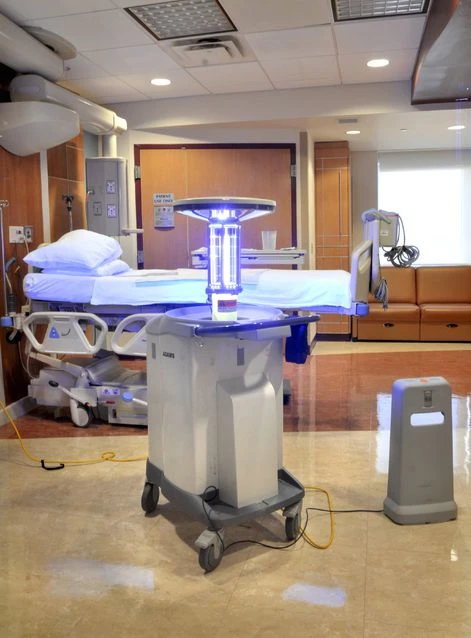Xenex, a robot that emits high-intensity ultraviolet light, kills germs in an operating room at Lancaster General Hospital (Image Credit: Dan Marschka, Lancaster Online)
Pulsing lights blink inside a glass-walled room in the intensive care unit at Lancaster General Hospital (LGH).
Meet LGH's newest housekeeper, and its newest weapon in the fight against infection.
Called Xenex, it's a small robot that emits high-intensity ultraviolet light to kill germs in rooms in the intensive care and trauma-neuro units, operating rooms and rooms where patients with infections recently have stayed at LGH.
"It is providing a cleaner environment for patients," said Dr. Neil Greene, chief of the infectious disease division at LGH.
LGH officials say the machines are particularly useful as hospitals everywhere are working to reduce the number of infections that patients acquire inside the hospital from other patients.
About one in 20 hospital patients will acquire such an infection, which adds more than $30 billion to health care costs every year, the U.S. Centers for Disease Control and Prevention estimates.
The machines work against infections such as MRSA, CRE and C. diff, superbugs that are resistant to many antibiotics. The machines also can reduce the spread of the flu and gastrointestinal viruses, its manufacturer says.
The portable machine arrived in March at LGH, where it has been used to clean more than 700 rooms since then.
The hospital has acquired three of the machines, bought for $82,000 each, and uses them in conjunction with traditional cleaning methods to eradicate bacteria.
After doing their regular cleaning, housekeepers place the machines inside patient bathrooms and on either side of patient beds, running them through a five-minute cycle of pulsing light designed to hit beds, floors, doorknobs, tables, equipment and any other surface where bacteria might lurk.
About the size of a large laundry hamper, the machine can be plugged into a wall. Staff have to leave the room when it is operating, because the intense light can harm eyes.
The machine has a light-emitting core that rises when in operation and lowers when not in use. A motion sensor is used to turn off the machine if anyone enters the room when it is operating.
At other hospitals, the machines have reduced MRSA infections by 45 percent and C. diff infections by as much as 67 percent.
"What the device does is offer an extra layer of safety," said Enda Flynn, executive vice president of the Texas-based Xenex, who came to LGH for a demonstration of the machine.
Scott Garrety, LGH's director of environmental services, said the hospital has worked to find the places where germs hide, such as on the inside of handrails and underneath doorknobs, and clean there.
The robot, he said, helps to ensure that bacteria are eradicated.
"You know that five-second rule, if you drop your lollipop? I joke that after this machine, you can leave it on the floor for a day and pick it up and eat it," he said.
LGH officials plan to acquire up to a dozen of the machines, using them to clean the emergency department, Women & Babies Hospital and potentially every room in LGH.
Introduced in 2010, Xenex is used in more than 100 hospitals in the U.S., including in five in Pennsylvania.
In a quirky twist, the machines all are given unique names by their manufacturer, for ease of service and referral. Flynn said some are named after presidents or historical figures, others after Star Wars figures.
LGH's machines are called Adams, Franklin and Galileo. The hospital has asked the factory to name one of its future machines Buchanan, after Lancaster's own president James Buchanan.
Source: Cindy Stauffer, Lancaster Online
Pulsing lights blink inside a glass-walled room in the intensive care unit at Lancaster General Hospital (LGH).
Meet LGH's newest housekeeper, and its newest weapon in the fight against infection.
Called Xenex, it's a small robot that emits high-intensity ultraviolet light to kill germs in rooms in the intensive care and trauma-neuro units, operating rooms and rooms where patients with infections recently have stayed at LGH.
"It is providing a cleaner environment for patients," said Dr. Neil Greene, chief of the infectious disease division at LGH.
LGH officials say the machines are particularly useful as hospitals everywhere are working to reduce the number of infections that patients acquire inside the hospital from other patients.
About one in 20 hospital patients will acquire such an infection, which adds more than $30 billion to health care costs every year, the U.S. Centers for Disease Control and Prevention estimates.
The machines work against infections such as MRSA, CRE and C. diff, superbugs that are resistant to many antibiotics. The machines also can reduce the spread of the flu and gastrointestinal viruses, its manufacturer says.
The portable machine arrived in March at LGH, where it has been used to clean more than 700 rooms since then.
The hospital has acquired three of the machines, bought for $82,000 each, and uses them in conjunction with traditional cleaning methods to eradicate bacteria.
After doing their regular cleaning, housekeepers place the machines inside patient bathrooms and on either side of patient beds, running them through a five-minute cycle of pulsing light designed to hit beds, floors, doorknobs, tables, equipment and any other surface where bacteria might lurk.
About the size of a large laundry hamper, the machine can be plugged into a wall. Staff have to leave the room when it is operating, because the intense light can harm eyes.
The machine has a light-emitting core that rises when in operation and lowers when not in use. A motion sensor is used to turn off the machine if anyone enters the room when it is operating.
At other hospitals, the machines have reduced MRSA infections by 45 percent and C. diff infections by as much as 67 percent.
"What the device does is offer an extra layer of safety," said Enda Flynn, executive vice president of the Texas-based Xenex, who came to LGH for a demonstration of the machine.
Scott Garrety, LGH's director of environmental services, said the hospital has worked to find the places where germs hide, such as on the inside of handrails and underneath doorknobs, and clean there.
The robot, he said, helps to ensure that bacteria are eradicated.
"You know that five-second rule, if you drop your lollipop? I joke that after this machine, you can leave it on the floor for a day and pick it up and eat it," he said.
LGH officials plan to acquire up to a dozen of the machines, using them to clean the emergency department, Women & Babies Hospital and potentially every room in LGH.
Introduced in 2010, Xenex is used in more than 100 hospitals in the U.S., including in five in Pennsylvania.
In a quirky twist, the machines all are given unique names by their manufacturer, for ease of service and referral. Flynn said some are named after presidents or historical figures, others after Star Wars figures.
LGH's machines are called Adams, Franklin and Galileo. The hospital has asked the factory to name one of its future machines Buchanan, after Lancaster's own president James Buchanan.
Source: Cindy Stauffer, Lancaster Online
Latest Articles
Infections, MRSA
Xenex, a robot that emits high-intensity ultraviolet light, kills germs in an operating room at Lancaster General Hospital (Image Credit: Dan Marschka, Lan...










